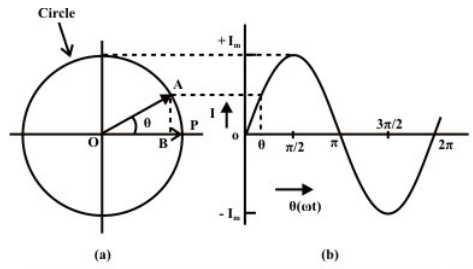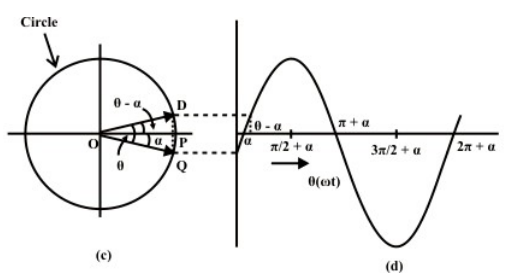Representation Of Sinusoidal Signal By A Phasor
Representation of Sinusoidal Signal by a Phasor: A sinusoidal quantity, i.e. current,  , is taken up as an example. In Fig. a, the length, OP, along the x-axis, represents the maximum value of the current Im, on a certain scale. It is being rotated in the anti-clockwise direction at an angular speed, ω , and takes up a position, OA after a time t (or angle, θ = ω t , with the x-axis). The vertical projection of OA is plotted in the right hand side of the above figure with respect to the angle θ . It will generate a sine wave (Fig. b), as OA is at an angle, θ with the x-axis, as stated earlier. The vertical projection of OA along y-axis is OC = AB =Iθ=im sinθ, which is the instantaneous value of the current at any time t or angle θ . The angle θ is in rad., i.e. θ = ω t . The angular speed, ω is in rad/s, i.e.ω = 2π f , where f is the frequency in Hz or cycles/sec. Thus,
, is taken up as an example. In Fig. a, the length, OP, along the x-axis, represents the maximum value of the current Im, on a certain scale. It is being rotated in the anti-clockwise direction at an angular speed, ω , and takes up a position, OA after a time t (or angle, θ = ω t , with the x-axis). The vertical projection of OA is plotted in the right hand side of the above figure with respect to the angle θ . It will generate a sine wave (Fig. b), as OA is at an angle, θ with the x-axis, as stated earlier. The vertical projection of OA along y-axis is OC = AB =Iθ=im sinθ, which is the instantaneous value of the current at any time t or angle θ . The angle θ is in rad., i.e. θ = ω t . The angular speed, ω is in rad/s, i.e.ω = 2π f , where f is the frequency in Hz or cycles/sec. Thus,
i= Im sinθ =Im sinωt=Imsin 2πft
So, OP represents the phasor with respect to the above current, i.
The line, OP can be taken as the rms value,  , instead of maximum value, Im . Then the vertical projection of OA, in magnitude equal to OP, does not represent exactly the instantaneous value of I, but represents it with the scale factor of
, instead of maximum value, Im . Then the vertical projection of OA, in magnitude equal to OP, does not represent exactly the instantaneous value of I, but represents it with the scale factor of  . The reason for this choice of phasor as given above, will be given in another lesson later in this module.
. The reason for this choice of phasor as given above, will be given in another lesson later in this module.
 (a)Phasor representation of a sinusoidal current, and (b) waveform
(a)Phasor representation of a sinusoidal current, and (b) waveform (c)Phasor representation of a phase shifted sinusoidal current (d) waveform
(c)Phasor representation of a phase shifted sinusoidal current (d) waveform
Generalized case : The current can be of the form,  as shown in Fig. (d). The phasor representation of this current is the line, OQ, at an angle,α (may be taken as negative), with the line, OP along x-axis (Fig. c). One has to move in clockwise direction to go to OQ from OP (reference line), though the phasor, OQ is assumed to move in anti-clockwise direction as given earlier. After a time t, OD will be at an angle θ with OQ, which is at an angle (θ−α = ω t −α ), with the line, OP along x-axis. The vertical projection of OD along y-axis gives the instantaneous value of the current,
as shown in Fig. (d). The phasor representation of this current is the line, OQ, at an angle,α (may be taken as negative), with the line, OP along x-axis (Fig. c). One has to move in clockwise direction to go to OQ from OP (reference line), though the phasor, OQ is assumed to move in anti-clockwise direction as given earlier. After a time t, OD will be at an angle θ with OQ, which is at an angle (θ−α = ω t −α ), with the line, OP along x-axis. The vertical projection of OD along y-axis gives the instantaneous value of the current,
